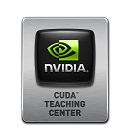Difference between revisions of "GPU610/DPS915"
(→Resources) |
(→The Project) |
||
| Line 25: | Line 25: | ||
<td> | <td> | ||
| − | * | + | * The course project is a three-stage, team assignment. Each team consists of 3 members. In the first stage your team evaluates 6 applications and selects 3 for continued work. The evaluation includes profiling to identify the hot spots in each application. Each team member is responsible for 2 of the candidate applications. The second stage refactors the applications to use the GPU, including shared memory. The third and final stage optimizes the performance. Each team presents the results of its work during the final week of the semester. |
| − | + | * Specifications | |
| − | The course project is a three-stage, team assignment | + | *# [[https://scs.senecac.on.ca/~gpu610/pages/assignments/a1.html Selection and Assessment]] |
| − | + | *# [[https://scs.senecac.on.ca/~gpu610/pages/assignments/a2.html GPU Programming]] | |
| + | *# [[https://scs.senecac.on.ca/~gpu610/pages/assignments/a3.html Optimization]] | ||
</td> | </td> | ||
<td> | <td> | ||
Revision as of 10:21, 31 August 2012
GPU610/DPS915 | Student List | Group and Project Index | Student Resources | Glossary
Please help make this page resourceful for all GPU610/DPS915 students to use!
Contents
Course Descriptions
GPU610 - Parallel Programming Fundamentals
- Modern GPU (Graphics Processing Unit) technology supports massively parallel computations, which complements the serial processing capabilities of CPU technology. This course teaches students how to read, write, and debug programs that use both CPU and GPU technology. Students learn to reorganize existing programs into serial code that runs on the CPU and parallel code that runs on the GPU. Students also study cases that have benefited from CPU+GPU programming.
- Course Outline
DPS915 - Introduction to Parallel Programming
- Modern GPU (Graphics Processing Unit) technology supports massively parallel computations, which complements the serial processing capabilities of CPU technology. This course teaches students how to read, write, and debug programs that use both CPU and GPU technology. Students learn to reorganize existing programs into serial code that runs on the CPU and parallel code that runs on the GPU. Students also study cases that have benefited from CPU+GPU programming and develop a CPU+GPU application for a client.
Common Material
External Links
The Project
|
Evaluation
- Assignment 30%
- Individual Work - 50%
- Group Work - 50%
- Total (Individual + Group) - 100%
- Workshops 20%
- Test 20%
- Exam 30%
Final Submission Requirements
- Under construction
Resources
- Software Support
- Wikis
- Subversion
